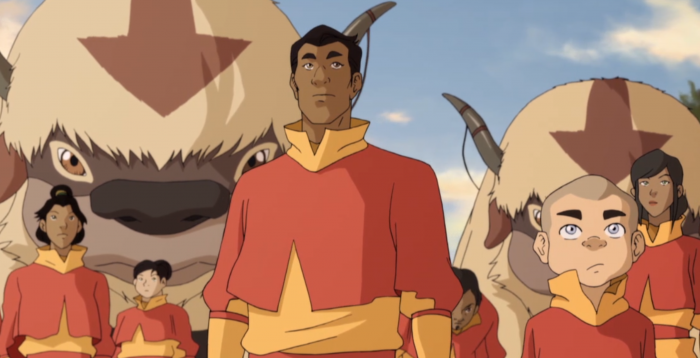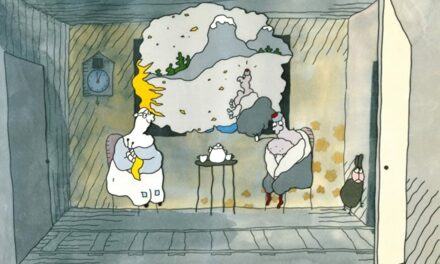
The third season of “The Legend of Korra” premiered this summer and featured its fair share of airbenders, villains and changes to the Avatar universe. Season four will premiere this Friday, Oct. 3 on Nick.com. | Courtesy of Nickelodeon
News recently broke that the premiere of the final season of “The Legend of Korra” will be released on Oct. 3. Naturally, this news delighted the show’s legions of fans, especially considering the success of the show’s third season, which debuted over the summer.
Similar to the majority of season three, season four will be streaming on Nick.com. However, releasing this on Nick.com rather than on television is doing a disservice to the series’ viewership and social awareness – because season three of “The Legend of Korra” is one of the best seasons of animation that Nickelodeon has ever produced.
Maybe I’m overpraising season three, but after the lackluster quality that this “Avatar: The Last Airbender” spinoff/sequel has had over its first two seasons, I have to admit that fans needed a breath of fresh air. The audience needed to see the full potential of the show, and “Season 3: Change” answered their call.
To give some background information, “The Legend of Korra” is set in a world where people are able to “bend” or control the elements of water, earth, fire and air. Avatar Korra, the guardian of both the physical and spiritual worlds, can bend all four elements. The main conflict appears when a new group of benders, who go by the name the Red Lotus, break out of prison and attempt to kidnap Korra in order to overthrow world governments and grant the people “true freedom,” a plan which involves killing the Avatar and descending into anarchy.
One of the most striking traits of this season is how much darker the show was willing to go. This season marks the first time it showed an on-screen death of a character by asphyxiation, and the finale involves Korra chained up after the Red Lotus has threatened mass murder. The following sequence had Korra wriggling in pure agony as the Red Lotus poisoned her, suffering hallucinations of her inner demons and past enemies. In fact, there were many times while I was watching where I wondered whether this was indeed a children’s show.
To say “The Legend of Korra” is simply a cartoon is vastly underselling it; it has deep philosophical viewpoints and political conflicts that resonate with our own world today. Issues on freedom versus security come into play, and the doubt created from questionable decisions that leaders make today connect with our own society.
But the main reason why the direction of the content worked was because of the focus on the characters, especially on the main antagonist and the supporting cast. “The Legend of Korra” has had a penchant of unimpressive villains ever since the first series. That’s not to say they weren’t formidable, but rather that their plans always seemed typical and unfulfilling, or their final downfall always ended anticlimactically.
To give an example, the finale of the second season involved the main antagonist becoming a giant Godzilla-sized spirit trying to destroy the physical world. In the end, it was resolved through a deus ex machina occurrence that can only be halfheartedly explained by: “magic?” But season three dug a little deeper.
The season’s main antagonist Zaheer had clear, direct, compelling goals, and he didn’t mess around; he made sure that no one, including Korra, got in the way of the Red Lotus. Zaheer’s arguments demonstrated a powerful statement on his view towards freedom. And what’s more important, he had the means and ways to accomplish his goal, similar to villains of our world. His backstory and relationship with his teammates made him seem human and relatable, despite his extreme vision. Zaheer made an excellent villain, and his team of benders matched Korra’s friends in duels with fantastic action that had me grinning in appreciation throughout the fights.
Supporting characters from previous seasons also had their chance to shine. A young airbender named Jinora went through a character arc where she sought to prove her worth as an airbending master. Her growth was shown through the progression of a father-daughter dynamic where her father was not ready to let go of her yet. Jinora is similar to Korra in a lot of ways, and in the end, seeing her take charge of teaching others airbending showed her development.
Another character explored was the police commissioner Lin Beifong. Lin is a character that we’ve seen many times throughout the series, yet this was the first season that fully disclosed her backstory. Lin’s flashbacks revealed her struggling relationships with her sister and mother. By illustrating her lack of personal relationships and strict adherence to the law, the show examined what made Lin so bitter and uncompromising. Although her character arc finished quite soon, I appreciated it nonetheless.
In terms of this season’s weaknesses, they were minimal. One of the weaknesses can be seen in the last episode of the season. Simply put, I thought it was extremely well executed, but similar to previous season finales, Red Lotus members also suffered various degrees of villain decay. They were taken out too easily by newly found power-ups and methods of the protagonists. In the finale, Korra and Zaheer participated in one of the greatest fights the series has ever seen, but Zaheer’s ultimate downfall was way too plot-convenient. Even the way Korra survived the poison seemed too dubious, as Zaheer seemed too intelligent of a person to ignore the obvious flaws in his plan.
Still, focusing on the supporting cast detracted from the powerful roles of the main characters. Korra went through her fair share of development this season, yet her sidekicks Mako and Bolin didn’t change their stagnant, trite personalities. Mako was still a brooding downer, while Bolin was a lovable, yet sometimes exasperating goofball. Although these characters had their own subplots, there was no “change,” which was frustrating because viewers wanted these characters to be distinguishable from the typical supporting roles seen in other television shows. However, I was willing to overlook this flaw since there was only so much “The Legend of Korra” could do in its limited number of episodes.
Furthermore, the season ended on a bittersweet, if somewhat grim, note. Even though Jinora became a master, Korra is thoroughly traumatized and incapacitated, showing the severity of what she experienced and emphasizing the stakes of what happened. This will be an interesting character arc that will doubtlessly be explored further in the final season of “Korra,” as viewers see the once brash, reckless Avatar changed into a weary, wounded warrior. We can only imagine what will come out of this character arc in “Korra’s” final season.
In the end, the third season of “The Legend of Korra” is no doubt the best season of the series, and one of the best seasons of animation I have ever seen. In a span of 13 episodes, the pacing is just right for a tightly-knit storyline. I highly recommend giving it a watch and diving into this universe with colorful characters, amazing action and an engaging storyline. 4.5 stars out of 5.
– By Jake Choi, Contributing Writer
The Emory Wheel was founded in 1919 and is currently the only independent, student-run newspaper of Emory University. The Wheel publishes weekly on Wednesdays during the academic year, except during University holidays and scheduled publication intermissions.
The Wheel is financially and editorially independent from the University. All of its content is generated by the Wheel’s more than 100 student staff members and contributing writers, and its printing costs are covered by profits from self-generated advertising sales.






